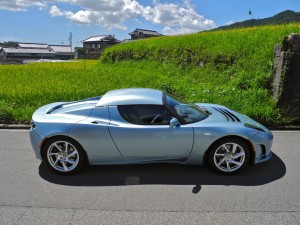When a former General Motors senior exec like Bob Lutz starts talking up electric cars, people listen. As we’ve featured on this site a couple of times, electric vehicles are coming, the question is; when exactly?
As Lutz points out, and as the boys on Top Gear have poked fun at mercilessly, the major problem for all electric cars is the battery, in particular how far a car can drive on one charge and how long it takes to recharge. Lutz also talks about the stated battery range being a maximum, that’s easily affected by the age of the battery and outside temperature. If outside temperature is too hot or too cold, battery strength can be reduced by up to 30%.
Despite these shortcomings, Lutz is still a believer, saying;
“The day will come when batteries will accept more charge, costs will come down, fast charging will happen, but the whole thing is 5-10 years away. At that point, who needs a gasoline engine anymore?”
Lutz also talks about US electric car manufacturer Tesla, who he believes have delivered on two out of three deliverables for electric cars: 300 mile range (480km) and rapid recharging. It hasn’t delivered on affordability, yet.
Meanwhile, technology developments may soon make the battery charge issue go away entirely. We reported a while ago about startup Better Place setting up electric car charging stations around Australia. Well the bad news is Better Place hasn’t been able to make it work and has effectively shut its doors.
But the new technology that may yet save the electric car is wireless charging. Wireless charging works just like those charging devices for iPhones, iPods etc. where you just leave the gadgets sitting on an inductive charger. In North Korea (yes, North Korea) there is a bus called the “Gapbus” which gets its power continuously from a power line embedded in the road. Inductive charging takes place as long as the bus is no more than 12 inches away from the road surface.
Car share companies are very keen on the technology as well, since one of their biggest problems is drivers forgetting to plug the car in when they return it, leaving the vehicle useless for the next user the following morning.
If inductive charging technology were taken on, long roads could be equipped with battery boost zones every so often, allowing electric vehicles to drive much further than their stated battery range.
Once the battery issue is addressed, electric vehicles will be superior to internal combustion engine vehicles in almost every respect, but here are four ways to think about:
- Torque available instantly: Cars like the Tesla demonstrate how useful this is. Instead of waiting for the engine to be at 1500rpm to generate torque, as with a petrol engined car, the Tesla has access to torque at 0rpm. This means powerful electric cars can hit impressive 0-60 times, and all completely silent.
- Best of both worlds: The new Porsche 918 hybrid gives the driver no less than 5 different modes – all the way from full electric to petrol engine and electric engine combined. In electric only mode the sports car is pretty nippy, can drive at up to 90mph (145kmh) and for about 15 miles (24kms) on the battery alone. The ‘Hot Lap Mode’ switches on both engines and enables the car to hit 60mph (97kmh) in under 3 seconds. The only problem is the price tag; at $845,000 it’s pretty steep even for Porsche.
- Braking gives you more power: As with the La Ferrari model we profiled before, many hybrids feature KERS technology (Kinetic Energy Recovery Systems) which convert energy otherwise lost in braking into battery power.
- Torque vectoring: Torque vectoring refers to those electric vehicles which have an electric motor at each wheel, like the Mercedes AMG SLS E-Drive. Giving even more power and road-holding than a conventional all-wheel-drive, this technology is touted as not only a performance upgrade, but a huge safety boost. Mercedes claim the model, at 750 horse power, is the most powerful electric car, and the most powerful AMG ever built.
The great thing about all these technology improvements on top end cars, is that they will – sooner or later- filter down to more affordable cars, making that car loan on your first electric car easier to handle!
Image credit: Raneko




